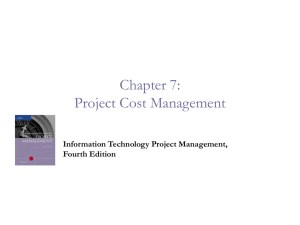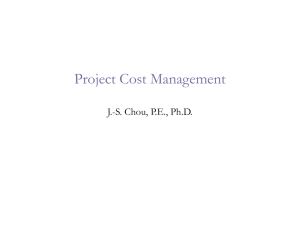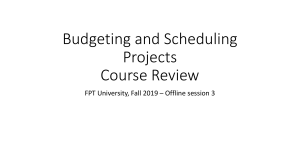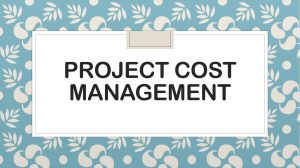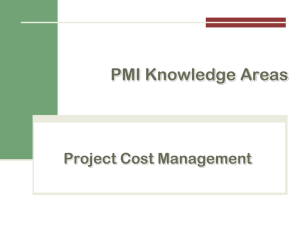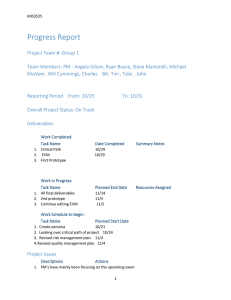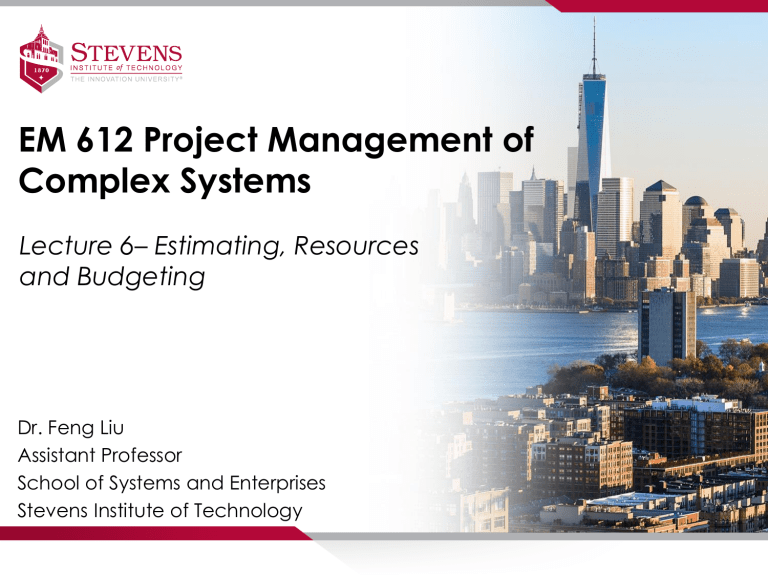
EM 612 Project Management of Complex Systems Lecture 6– Estimating, Resources and Budgeting Dr. Feng Liu Assistant Professor School of Systems and Enterprises Stevens Institute of Technology Part 1: Controlling the Schedule 2 Part 1: Controlling the Schedule • Goals of control schedule: – – – – know the status of the schedule influence factors that cause schedule changes determine if the schedule has changed, and manage changes when they occur • Tools and techniques include – Progress reports – A schedule change control system – Project management software, including schedule comparison charts like the tracking Gantt chart – Variance analysis, such as analyzing float or slack 3 Schedule Control Suggestions • Perform reality checks on schedules • Allow for contingencies • Don’t plan for everyone to work at 100% capacity all the time • Hold progress meetings with stakeholders and be clear and honest in communicating schedule issues Buffers and Critical Chain • Buffer: additional time to complete a task • Murphy’s Law: if something can go wrong, it will • Parkinson’s Law: work expands to fill the time allowed (e.g. submitting your report in the last minute) • People often add a buffer to each task and use it if it’s needed or not Discussion on Buffer and Critical Chain: Tenera, A. B. (2008). Critical chain buffer sizing: a comparative study. Paper presented at PMI® Research Conference: Defining the Future of Project Management, Warsaw, Poland. Newtown Square, PA: Project Management Institute. https://www.pmi.org/learning/library/critical-chain-project-management-theory7118 5 Three-Point Estimates • Instead of providing activity estimates as a discrete number, such as four weeks, it’s often helpful to create a three-point estimate – an estimate that includes an optimistic, most likely, and pessimistic estimate, such as three weeks for the optimistic, four weeks for the most likely, and five weeks for the pessimistic estimate – Estimated time using three-point estimate: T = (OT+MLT+PT)/3 6 Program Evaluation and Review Technique (PERT) • PERT is a network analysis technique used to estimate project duration when there is a high degree of uncertainty about the individual activity duration estimates • PERT uses probabilistic time estimates – duration estimates based on using optimistic, most likely, and pessimistic estimates of activity durations, or a three-point estimate 7 PERT Formula and Example • PERT weighted average = optimistic time + 4X most likely time + pessimistic time 6 • Example: PERT weighted average = 8 workdays + 4 X 10 workdays + 24 workdays = 12 days 6 If we use three-point estimate, what’s the estimated duration ? where optimistic time= 8 days most likely time = 10 days, and pessimistic time = 24 days Therefore, you’d use 12 days on the network diagram instead of 10 when using PERT for the above example 8 Crashing & Fast tracking • Crashing: adding resources to reduce the project duration. Crashing adds costs to the project • Fast tracking: Allows projects phases to overlap to reduce the project duration. Fast tracking adds risk to the project. 9 Part 2: Cost management 10 Part 2.1: What is Project Cost Management? (1 of 2) • Project cost management includes the processes required to ensure that the project is completed within an approved budget – Planning cost management: determining the policies, procedures, and documentation that will be used for planning, executing, and controlling project cost – Estimating costs: developing an approximation or estimate of the costs of the resources needed to complete a project – Determining the budget: allocating the overall cost estimate to individual work items to establish a baseline for measuring performance – Controlling costs: controlling changes to the project budget What is Project Cost Management? (2 of 2) ITTOs Basic Principles of Cost Management (1 of 3) • Most members of an executive board better understand and are more interested in financial terms than IT terms; they need to be able to present and discuss the following project information – Profits: revenues minus expenditures – Profit margin: ratio of profits to revenues – Life cycle cost: considers total cost of ownership, or development plus support costs, for a project – Cash flow analysis: determines estimated annual costs and benefits for a project and resulting annual cash flow Basic Principles of Cost Management (2 of 3) Types of costs and benefits – Tangible costs or benefits are those costs or benefits that an organization can easily measure in dollars – Intangible costs or benefits are costs or benefits that are difficult to measure in monetary terms (reputation skill level of employees) – Direct costs: Costs are attributed directly to the project work and cannot be shared among projects (for example, airfare, hotels, longdistance phone charges, and so on). – Indirect costs: Costs that are representative of more than one project (for example, utilities for the performing organization, access to a training room, PM software license, and so on). – Fixed cost: Constant through the project. Rented equipment, fixedprice consultant – Variable cost: Vary based on conditions in the project (# of participants, supply and demand of materials) – Sunk cost: is money that has been spent in the past; when deciding what projects to invest in or continue, you should not include sunk costs Basic Principles of Cost Management (3 of 3) • Additional concepts – Learning curve theory states that when many items are produced repetitively, the unit cost of those items decreases in a regular pattern as more units are produced – Reserves are dollars included in a cost estimate to mitigate cost risk by allowing for future situations that are difficult to predict • Contingency reserves allow for future situations that may be partially planned for (sometimes called known unknowns) and are included in the project cost baseline. Comment: Contingency reserve need not refer exclusively to monetary terms. It can also refer to a specific quantity of time in man hours. • Management reserves allow for future situations that are unpredictable (sometimes called unknown unknowns) Management reserves is not part of the performance measurement baseline (PMB), but is included in the total contract budget. Stated another way, the contract budget base (CBB) is equal to the PMB plus MR. Cost Management Plan • Subsidiary plan of the project management plan • Addresses three other cost management processes – How cost are estimated – How the project budget is managed – How cost will be controlled 16 Planning Cost Management • • The first step in project cost management is planning how the costs will be managed throughout the life of the project – The project team uses expert judgment, analytical techniques, and meetings to develop the cost management plan Cost management plan includes: – Level of accuracy (rounding, contingency to include – 10 or 20%) – Units of measure (labor hours, days, etc) – Organizational procedure links (e.g., WBS component used for project cost accounting known as the control account, Project teams charges cost toward this account) – Control thresholds (e.g., similar to variance, variation allowed, e.g., 10%) – Rules of performance measurement (i.e., how often actual costs will be tracked and to what level of detail) – Reporting formats (format and frequency of reports required) – Process descriptions (describes how to perform all of the cost management processes) Part 2.2: Cost Estimation Tools and Techniques • Analogous or top-down estimates – Use the actual cost of a previous, similar project as the basis for estimating the cost of the current project • Bottom-up estimates – Involve estimating individual work items or activities and summing them to get a project total • Three-point estimates – Involve estimating the most likely, optimistic, and pessimistic costs for items • Parametric estimating – Uses project characteristics (parameters) in a mathematical model to estimate project costs Hybrid model – where combination of 2 or more (all) can be used Estimating Costs (1of 3) Project managers must take cost estimates seriously if they want to complete projects within budget constraints Type of Estimate When Done (a 5-year project) Why Done Typical Range Rough order of magnitude (ROM) Very early in the project life cycle, often 3–5 years before project completion Provides estimate of cost for selection decisions -25% to + 75% Budgetary Early, 1–2 years out Puts dollars in the budget plans -10% to +25% Definitive Later in the project, less than 1 year out Puts dollars in the budget plans -5% to +10% Table 7-1 Types of cost estimates Estimating Costs (2 of 3) • The number and type of cost estimates vary by application area – The Association for the Advancement of Cost Engineering International identifies five types of cost estimates for construction projects • Order of magnitude, conceptual, preliminary, definitive, and control – Estimates are usually done at various stages of a project • Should become more accurate as time progresses – It is important to provide supporting details for estimates and updates to project documents – A large percentage of total project costs are often labor costs Estimating Costs (3 of 3) Department Year 1 Year 2 Year 3 Year 4 Year 5 Totals Information systems 24 31 35 13 13 116 Marketing systems 3 3 3 3 3 15 Reservations 12 29 33 9 7 90 Contractors 2 3 1 0 0 6 Totals 41 66 72 25 23 227 Table 7-2 Maximum FTE (full time equivalent) by department by year How to Develop a Cost Estimate and Basis of Estimates (1 of 3) Before creating an estimate gather as much information as possible about the project, ask how the organization plans to use the cost estimate, and clarify the ground rules and assumptions How to Develop a Cost Estimate and Basis of Estimates (2 of 3) • • This shows the cost per WBS item Asterisks (SW Development) above provides a reference regarding how this estimation was made – Higher of two estimation (Labor estimate versus Function Points estimate) was chosen as long as difference is no more than 20%– see comparison in next slide How to Develop a Cost Estimate and Basis of Estimates (3 of 3) • • Labor estimate versus Function Points estimate comparison – Definition: Function points are a means of measuring software size in terms that are meaningful to end users Lastly, it is very important to have several people review the project cost estimate Best Practice • Alvin Alexander wrote a book called Cost Estimating in an Agile Development Environment in 2015 – Function points are a means of measuring software size in terms that are meaningful to end users – User stories are a common way to describe requirements in a simple, concise way – Developers can analyze user stories for function points Definitions: A user story is a tool used in Agile software development to capture a description of a software feature from an end-user perspective. A user story describes the type of user, what they want and why. A user story helps to create a simplified description of a requirement. The function point is a "unit of measurement" to express the amount of business functionality an information system provides to a user. Typical Problems with Cost Estimates • Reasons for inaccuracies – Estimates are done too quickly – People lack estimating experience – Human beings are biased toward underestimation Part 2.3: Determining the Budget (1 of 2) • Budgeting involves allocating the project cost estimate to individual work items over time – Material resources or work items are based on the activities in the WBS for the project • Important goal is to produce a cost baseline – Time-phased budget that project managers use to measure and monitor cost performance Determining the Budget (2 of 2) Project Budget… includes estimates + Reserves A control account is a management control point at which budgets (resource plans) and actual costs are accumulated and compared to earned value for management control purposes. 29 Project Budget Component • Project budget is composed of Cost baseline plus Management reserve • Control Accounts are work package cost estimates plus contingency reserve • And work package cost estimates is activity cost estimate plus activity contingency reserve Part 2.4: Controlling Costs • Activities involved in controlling project costs – Monitoring cost performance – Ensuring that only appropriate project changes are included in a revised cost baseline – Informing project stakeholders of authorized changes to the project that will affect costs • Several tools and techniques assist in project cost control – Expert judgment, data analysis, project management information systems, and the to-complete performance index Earned Value Management (EVM) (1 of 3) • EVM is project performance measurement technique that integrates scope, time, and cost data – Given a cost performance baseline (original plan plus approved changes), project managers can determine how well the project is meeting the scope, time and cost goals (by entering actual information and compare to baseline) – EV provides early warning signs, helping to control scope, time and cost • Current performance is the best indicator of future performance, and, therefore, using trend data, it is possible to forecast cost or schedule overruns at an early stage in a project. • In a nutshell, Earned Value is an approach where you monitor the project plan (or planned value), actual work (Actual cost), and work completed (Earned value) value to see if a project is on track. Example Find the calculator in the excel file on canvas 33 Earned Value Management (EVM) (2 of 3) • Calculating three values for each activity or summary activity Table 7-3 Earned value calculations for one activity after week 1 • Planned Value (PV) = Suppose purchasing and installing a new web server is estimated as 1 week for 10k • Actual Cost (AC) = It actually took 2 weeks and cost of 20K (week1=15K, week2 = 5K) • Earned Value (EV) = PV of all completed work • If 1 week work is estimated in PV with a corresponding $ amount (e.g., 1 week, and cost is 10K), but actual work took for 2 weeks with each week incurring a different amount (Week1=15K, week2= 5K), then, according to budget/plan 1week should cost 5 for total PV of10K, AND 10K-5K = EV. Activity Week 1 Earned value (EV) = PV of all completed work 5,000 Planned value (PV) 10,000 Actual cost (AC) 15,000 Cost variance (CV) = EV - AC -10,000 Schedule variance (SV) = EV - PV -5,000 Cost performance index (CPI) = EV/AC 33% Schedule performance index (SPI) = EV/PV 50% Estimate at completion (EAC) EAC = BAC/CPI – ( BAC is Budget At Completion) and EAC is Estimate At Completion) Estimated to Complete (ETC) ETC = EAC – AC TCPI is a measure of the cost performance that must be achieved with remaining resources to meet EAC or BAC To meet the current EAC: TCPI = (BAC-EV) / (EAC-AC) To complete on plan or meet the BAC: TCPI = (BAC-EV) / (BAC-AC) • Basically, if variances are positive, then project is on track or under budget – good – Cost variance (CV) = EV - AC – Schedule variance (SV) = EV – PV • If index es are at/above 100%, then project is on track or under budget – Cost performance index (CPI) = EV/AC – Schedule performance index (SPI) = EV/PV Earned Value Management (EVM) (3 of 3) Usage of EVM • EVM is used worldwide, and it is particularly popular in the Middle East, South Asia, Canada, and Europe – Most countries require EVM for large defense or government projects, as shown in Figure – EVM is also used in such privateindustry sectors as IT, construction, energy, and manufacturing. • However, most private companies have not yet applied EVM to their projects because management does not require it, feeling it is too complex and not cost effective Using Project Management Software to Assist in Project Cost Management (1 of 2) • Spreadsheets are a common tool for resource planning, cost estimating, cost budgeting, and cost control – Many companies use more sophisticated and centralized financial applications software for cost information • Project management software can increase a project manager’s effectiveness during each process of project cost management – Many IT project managers use other tools to manage cost information because they do not know that they can use project management software, or they do not track costs based on a WBS, as most project management software does Using Project Management Software to Assist in Project Cost Management (2 of 2) • Recent Studies on Project Portfolio Management (PPM) Software – 2017 Gartner report says the market continues to grow, with annual sales over $2.3 billion – Forrester estimates ROIs of 250 percent from PPM tools – Pfizer and Ford use PPM software to improve transparency of the many projects they manage Summary Project managers must understand several basic principles of cost management to be effective in managing project costs Main processes Plan cost management Estimate costs Determine the budget Control costs Several software products can assist with project cost management • After class reading content 41 Considerations for Agile/Adaptive Environments • AgileEVM is an adapted implementation of EVM – Uses the Scrum framework artifacts as inputs, uses traditional EVM calculations, and is expressed in traditional EVM metrics – Requires a minimal set of input parameters • Actual cost of a project, an estimated product backlog, a release plan that provides information on the number of iterations in the release and the assumed velocity – All estimates can be in hours, story-points, team days or any other consistent estimate of size • The critical factor is that it must be a numerical estimate of some kind

